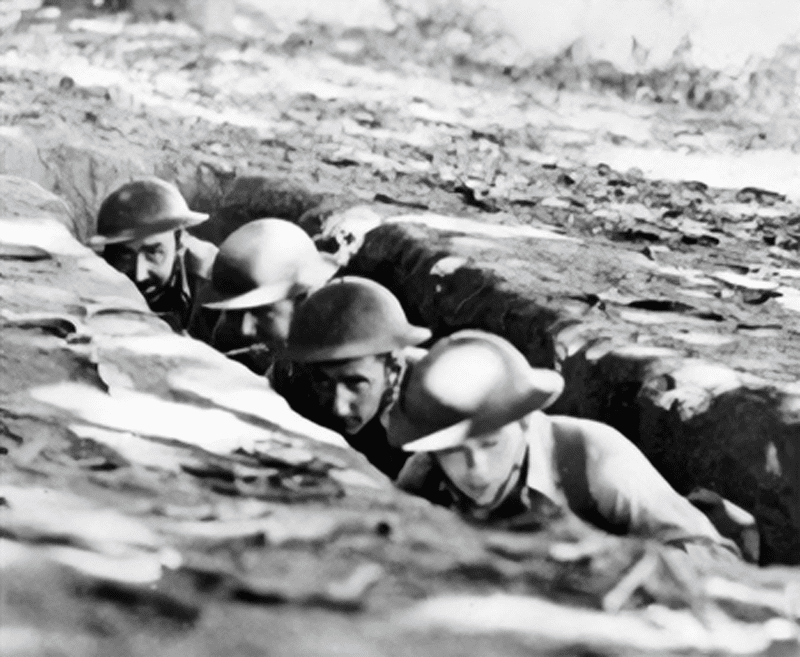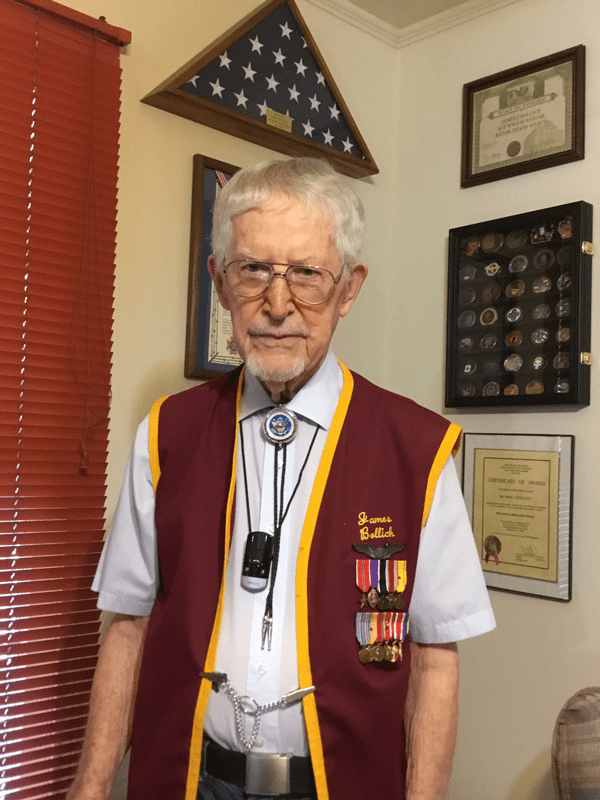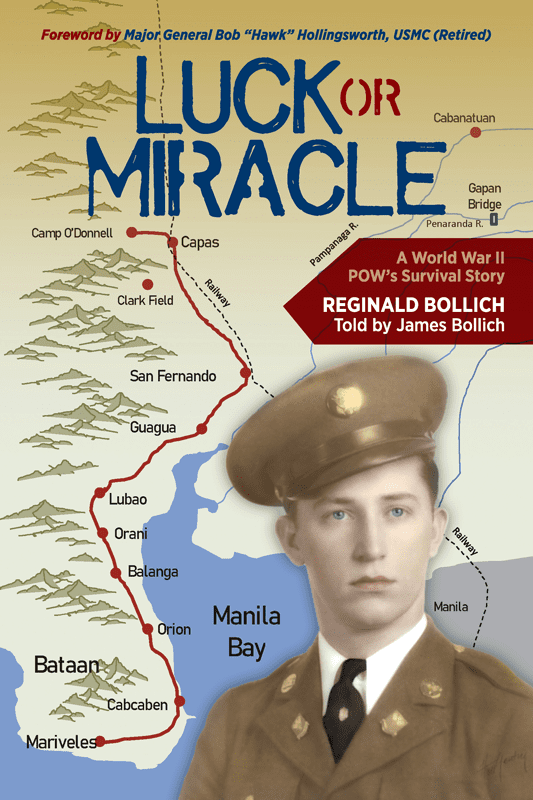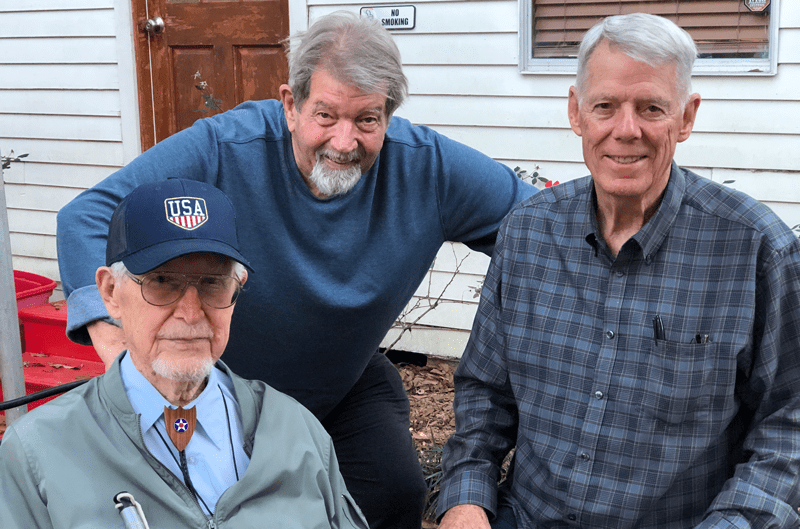In 1921, the first BCG vaccination against tuberculosis is given, in Paris, France… the World Series baseball game is first broadcast on the radio… future American president Franklin Delano Roosevelt (FDR) is diagnosed with polio… physicist, chemist and two-time Nobel Prize winner Marie Curie publishes The Discovery of Radium… James Bollich, along with U.S. astronaut John Glenn, Prince Philip, Soviet physicist and Nobel Peace Prize laureate Andrei Dmitrievich Sakharov, is born.
At 100 years of age in 2021, James Bollich of Lafayette, Louisiana, was among fewer than 90,000 centenarians alive in the United States, the population of which was a little under 337 million, according to data from the Population Division of the United Nations. A treasure trove of over a century of historical information and life experiences, Bollich, now 102, has had the foresight to commit his memories to the printed page of two books (first, in 1993’s Bataan Death March and now in the just-released Luck or Miracle) and preserve them for the annals of history.
The first book recorded his time as a prisoner of war (POW) during World War II, and the second book – an oral history told to his cousin, Reginald Bollich, who taped James’ story into a voice recorder over a period of three weeks – covers some of the same ground but, as Reginald explains, “The difference is the verbal treatment and details of his survival and suffering offered in this account.” The new book also touches on his career after the war as a geologist for Tenneco, where he spent 29 years until his retirement in 1986.
“After the war, I started studying geology at the local college. From there, I did graduate work at the University of New Mexico and further study at the University of Wyoming. While I was there, I received a Fulbright scholarship to do my PhD dissertation at the University of Queensland.”
Originally, Bollich’s goal in pursuing higher education was to become a geology professor.
“When I got to Australia and met with the head of the geology department, he asked me, “How did you make this up?” referring to Bollich’s idea for his dissertation. I said, “We had maps of Australia in our library.” He wasn’t impressed at all. He said, “Those maps were made by people like me sitting in offices. You’re likely to go out there and not find anything at all like the map. Even if it were right, you’d need an army of men with their own food and water. That’s out in the wilderness.”
“Right off the bat,” Bollich says laughing, “I knew I was in big trouble.”


While he was in Australia, Bollich received a letter from the University of Louisiana (then Southwest Louisiana Institute), offering him a job teaching geology which, at the time, fell under the geography department, but Bollich says he wasn’t interested. Instead, upon his return to the U.S., he took a job with Tidewater Oil Company in Houston.
“Once I went to work for an oil company, man, that was for me! I still did a lot of teaching [on the job] every time we got a new geologist. I put out a book for beginning geologists called Interpreting Subsurface Geology of the Gulf of Mexico Basin during the Arab oil embargo in 1973 because companies were hard up and they were hiring geologists who knew nothing about the oil industry.”
Bollich recently had the book bound and wants to send the few copies he has to the geology departments at his alma maters: The University of Louisiana, the University of New Mexico and the University of Wyoming. The University of Queensland will also receive one. “I don’t know what they’re going to do with it,” he says laughing, “but they’re going to get it.”
“I would say being a geologist was a lot better than teaching,” Bollich muses. “The professor that I was going to replace when I got back to Louisiana had just gotten a job with an oil company – that’s why he left! And I got a job with an oil company, so why would I take his job? That would have been a backward move.”
Bollich was later transferred from Houston to Lafayette, where he was approached by Tennessee Gas Transmission (eventually, after many name changes over the years, the company would become Tenneco).
It was an easy decision to switch employers. “They offered me double the salary.” Bollich started strictly onshore (he points out that this was long before widespread offshore exploration in the Gulf of Mexico). Later, Tenneco had offshore leases and geologists were assigned to certain wells in the Gulf of Mexico where they ran logs. “That was our job. In those days, we were not offered water safety training. If the boat sank or the helicopter went down, I would have had to swim to shore! Sometimes, we were over 100 miles offshore; I don’t think I would have made it,” Bollich says, laughing.
“I used to have to drive [about three hours from Lafayette] to Grand Isle or catch a boat that would take us out to the rig. Then, when we got to the rig, there was a basket that lifted us up to the platform. Once we got helicopters, they would land on top of the office and all I had to do was get out. Man, you talk about a big improvement!”
One of the most exciting projects Bollich worked on during his time with Tennessee Gas was when the company decided that, instead of buying gas for its pipelines, it would explore for its own gas. Bollich, who worked for the company for 29 years, says he enjoyed his work from the first day to the last. “It was an unbelievable job.”
Looking back, he has no regrets that he didn’t become Professor Bollich. “I was real pleased working as a subsurface geologist here in Lafayette. If I had my career to do again, I would do the same thing.”
When Bollich met Celia Hendren – whom he would go on to marry in 1951 and remain married to for 65 years until her passing in 2016 – he was fortunate to find a woman with similar interests and educational background, as she was one of the few female geologists (particularly one specializing in macro-paleontology) at that time. Luck or miracle?
Headline photo: L to R: James Bollich, his cousin, Reginald Bollich, and Major General Bob “Hawk” Hollingsworth, USMC (Retired). Photos courtesy of James Bollich.


Preface
By Reginald Bollich
The 102nd birthday of my cousin, James “Jim” Joseph Bollich, was celebrated on August 15, 2023, at his home in Lafayette, Louisiana. Jim is one of only two other Bataan Death March survivors known to us who are alive today.
As a World War II Prisoner of War (POW), Jim suffered and survived the worst atrocities that humans can perpetrate on one another, that is, crimes inflicted on him by the Imperial Japanese Army. But after he was freed from captivity and with the war over, he did not allow their brutal treatment to distract nor deter him from his interests and what he had to do. Upon returning home, he immediately resumed his college studies the war had interrupted, received two degrees in geology, married Celia Herndon (1924 – 2016), and completed post-graduate studies as a Fulbright scholar in Australia. Jim moved to Lafayette, Louisiana, to earn a living as a geologist, raised his family, taught his two daughters the values of caring for wildlife, wrote fictional and non-fictional books, painted beautiful works of art on canvas, and crafted stained glass windows featuring fowl and fauna for his home.
After retiring, he became a gardener of orchids and an avid bird watcher. In his backyard, he fed birds, raised raccoons, and nursed orphaned baby possums by feeding them with an eye dropper. Currently, Jim spends his time growing milk-weed and fostering caterpillars in meshed cages to help save Monarch butterflies from extinction. In the evening, he treats his furry nocturnal friends with leftovers, especially his most favored possum named Gumbo.
In 1993, Jim published Bataan Death March: A Soldier’s Story, a book that narrates many of the events that are written in this book. The difference is the verbal treatment and details of his survival and suffering offered in this account, Luck or Miracle. This story is about courage and the will to live. It is told from the voice, coherent mind, and soul of a man, who at the age of 102, felt compelled to isolate and describe those times when his life was fleeting, when he specifically faced death from thirst, from explosives of aerial bombs, torpedoes, and a floating mine, from topside of a disabled ship in a violent sea storm, from being beaten, shot or stabbed for no reason. Jim wanted to talk, so I listened, and captured his words on a voice recorder at his home in July 2023. I offer to you his words to read and pass on to others, especially our American youth, “lest we forget.”

Book Excerpt: Luck or Miracle
By Reginald Bollich | Told by James Bollich
On the day after pulling anchor in Manila, the Tottori Maru skipper evaded three torpedoes fired from the American submarine USS Spearfish. Arriving in Pusan 32 days later, Jim [Bollich] and 75-80 others were so ill that they could not continue with the rest of the POWs. Only approximately thirty-five survived to later be transported to the permanent POW camp in Mukden, Manchuria.
Upon arrival, with new shoes and Japanese clothes, he weighed ninety-two pounds. He endured imprisonment in Mukden camp until he was liberated by the Russian army on his 24th birthday, August 15, 1945. During captivity, he and the other POW enlistees were fed three meager meals a day of cornmeal mush and soybean soup. During his three and a half years of confinement, he was afflicted with several diseases including malaria, dysentery, Beri-Beri, hepatitis, scurvy, pneumonia and frostbite, in addition to malnutrition. POW enlistees were not allowed pen and paper to record their experiences, so he relied on his memory to recall the details and chronology of events he experienced. After almost 50 years of holding his story inside, Jim wrote about what he endured and witnessed in his 1993 book Bataan Death March: A Soldier’s Story (originally titled A Soldier’s Journal).
While being held captive, Jim and fellow POW William Frising, a Marine from New York who was captured on Corregidor, became friends. One month after gaining their freedom, he and Frising were transported by truck and rail to Port Arthur, China (now Darien China) where they boarded the USS Colbert to begin their sea journey home to America. But during the night of September 16, 1945, the USS Colbert, while navigating through a typhoon, struck a floating mine that exploded causing a gaping hole in the hull. Several seamen were lost, some presumably swept out to sea, while three passengers on board the Colbert were fatally injured – two sailors in the boiler room and William Frising. The ship survived and returned to Okinawa. From there, the POWs were placed in the bomb bay sections of four B-24 planes and flown to Manila. The bomb bay door of one of the B-24s accidentally opened and the POWs aboard fell to their deaths. A short while later in Manila, Jim boarded a ship with several returning POWs and convoyed to San Francisco. After remaining in hospitals for several weeks, he eventually returned home to Louisiana.
Post-World War II
In the fall of 1945, before returning to his boyhood home, Jim stopped at a barber shop in Crowley, Louisiana, for a haircut. It was there that he learned for the first time, from the barber, the fate of his two brothers, Andrew and Stephen, who died in Europe during the war. Second Lt. Andrew Leo Bollich, a P-40 pilot with the 319th Fighter Squadron, went missing in action during a combat flight over southern Sardinia on June 24, 1943. Second Lt. Stephen Joseph Bollich, a B-24 bombardier with the 758th Bomb Squadron, 459th Bomb Group, died of severe head injury in Foggia, Italy, on March 27, 1944.
Jim retired from the U.S. Army Air Corps on February 17,1946, with the rank of sergeant. Soon after, he re-enrolled in the college at Lafayette and completed his bachelor’s degree in 1948. After graduating, he continued his education at the University of New Mexico (Albuquerque, NM) and the University of Wyoming (Laramie, WY), where he received a Fulbright Scholarship for post-graduate geological research at the University of Queensland (Brisbane, Australia). He met paleontologist, Celia Faith Hendren, at the University of New Mexico and married her in 1949. He returned to Lafayette, Louisiana, in 1953 to raise his family and work for Tenneco Oil Company until his retirement in 1986.
Excerpted with permission. Luck or Miracle by Reginald Bollich, told by James Bollich (Modern History Press; October 2023).
Reprint from OILMAN Magazine – November/December 2023
Rebecca Ponton has been a journalist for 25+ years and is also a petroleum landman. Her book, Breaking the GAS Ceiling: Women in the Offshore Oil and Gas Industry (Modern History Press), was released in May 2019. For more info, go to www.breakingthegasceiling.com.

